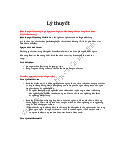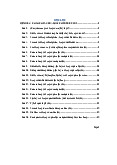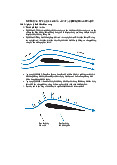




Preview text:
13: Ice protection Contents Page Introduction 147 Hot air system 149 Electrical system 150 INTRODUCTION
1. Icing of the engine and the leading edges of the intake duct can occur during flight through clouds
containing supercooled water droplets or during
ground operation in freezing fog. Protection against ice formation may be required since icing of
these regions can considerably restrict the airflow through the engine, causing a loss in performance
and possible malfunction of the engine. Additionally, damage may result from ice breaking away and
being ingested into the engine or hitting the acoustic material lining the intake duct.
2. An ice protection system must effectively prevent ice formation within the operational
requirements of the particular aircraft. The system must be reliable, easy to maintain, present no
excessive weight penalty and cause no serious loss in engine performance when in operation.
3. Analyses are carried out to determine whether ice protection is required and, if so, the heat input
required to limit ice build up to acceptable levels. Fig. 13-1 illustrates the areas of a turbo-fan engine
typically considered for ice protection.
4. There are two basic systems of ice protection; turbo-jet engines generally use a hot air supply (fig.
13-2), and turbo-propeller engines use electrical power or a combination of electrical power and hot
air. Protection may be supplemented by the circulation of hot oil around the air intake as shown in
fig. 13-3. The hot air system is generally used to prevent the formation of ice and is known as an
antiicing system. The electrical power system is used to break up ice that has formed on surfaces and is known as a de-icing system. HOT AIR SYSTEM
5. The hot air system provides surface heating of the engine and/or powerplant where ice is likely to
form. The protection of rotor blades is rarely necessary, because any ice accretions are dispersed by
centrifugal action. If stators are fitted upstream of the first rotating compressor stage these may
require protection. If the nose cone rotates it may not need anti-icing if its shape, construction and
rotational characteristics are such that likely icing is acceptable.
6. The hot air for the anti-icing system is usually taken from the high pressure compressor stages. It is
ducted through pressure regulating valves, to the parts requiring anti-icing. Spent air from the nose
cowl anti-icing system may be exhausted into the compressor intake or vented overboard.
7. If the nose cone is anti-iced its hot air supply may be independent or integral with that of the nose
cowl and compressor stators. For an independent system, the nose cone is usually anti-iced by a
continuous unregulated supply of hot air via internal ducting from the compressor.
8. The pressure regulating valves are electrically actuated by manual selection, or automatically by
signals from the aircraft ice detection system. The valves prevent excessive pressures being
developed in the system, and act also as an economy device at the higher engine speeds by limiting
the air offtake from the compressor, thus preventing an excessive loss in performance. The main
valve may be manually locked in a pre-selected position prior to take-off in the event of a valve
malfunction, prior to replacement. ELECTRICAL SYSTEM
9. The electrical system of ice protection is generally used for turbo-propeller engine installations, as
this form of protection is necessary for the propellers. The surfaces that require electrical heating are
the air intake cowling of the engine, the propeller blades and spinner and, when applicable, the oil cooler air intake cowling.
10. Electrical heating pads are bonded to the outer skin of the cowlings. They consist of strip
conductors sandwiched between layers of neoprene, or glass cloth impregnated with epoxy resin. To
protect the pads against rain erosion, they are coated with a special, polyurethane-based paint.
When the de-icing system is operating, some of the areas are continuously heated to prevent an ice
cap forming on the leading edges and also to limit the size of the ice that forms on the areas that are
intermittently heated (fig.13-4).
11. Electrical power is supplied by a generator and, to keep the size and weight of the generator to a
minimum, the de-icing electrical loads are cycled between the engine, propeller and, sometimes, the airframe.
12. When the ice protection system is in operation, the continuously heated areas prevent any ice
forming, but the intermittently heated areas allow ice to form, during their 'heat-off period. During
the 'heaton' period, adhesion of the ice is broken and it is then removed by aerodynamic forces.
13. The cycling time of the intermittently heated elements is arranged to ensure that the engine can
accept the amount of ice that collects during the 'heat-off' period and yet ensure that the 'heat-on1
period is long enough to give adequate shedding, without causing any run-back icing to occur behind the heated areas.
14. A two-speed cycling system is often used to accommodate the propeller and spinner
requirements; a 'fast' cycle at the high air temperatures when the water concentration is usually
greater and a 'slow' cycle in the lower temperature range. A typical cycling sequence chart is shown in fig, 13-5



